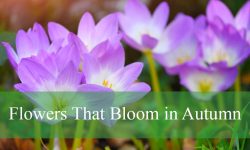Coreopsis varieties are some of the most cheerful and easy-to-grow flowering plants you can add to your garden. Known for their bright, daisy-like blooms, these plants bring vibrant color from early summer through fall. Whether you have a large flower bed or a small container garden, there’s a type of Coreopsis that will fit perfectly.
There are many types of Coreopsis available, each with unique flower colors, shapes, and growth habits. From compact mounds to tall, airy plants, these varieties offer something for every gardener’s style and climate. Their ability to attract pollinators like bees and butterflies makes them not only beautiful but also beneficial to your garden ecosystem.
Choosing the right Coreopsis varieties can brighten up your outdoor space with minimal effort. These hardy plants thrive in full sun and well-draining soil, and many types are drought-tolerant once established. In this article, you’ll discover 20 of the best Coreopsis varieties to grow, complete with pictures and growing tips to help your garden burst with color.
Different Types of Coreopsis
Hot Paprika
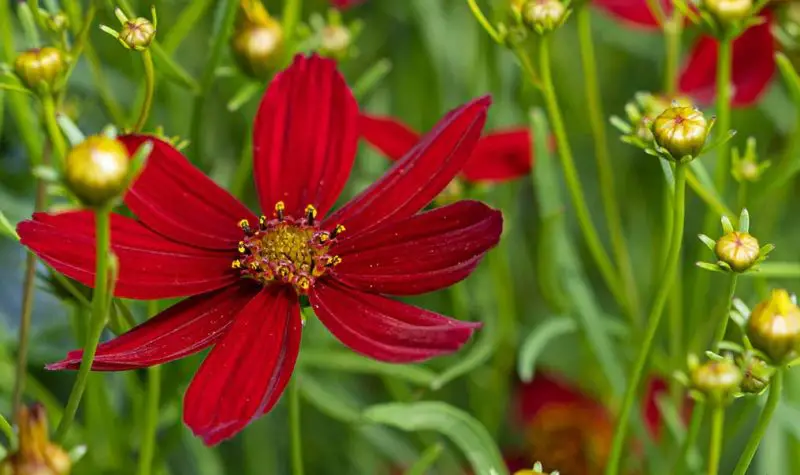
Hot Paprika is a striking coreopsis variety that produces intense red-orange blooms with a slightly darker center. Its fiery color adds warmth and vibrancy to any flower bed, rock garden, or container planting. The flowers are daisy-like and abundant, providing a continuous splash of color.
This variety typically grows 12 to 16 inches tall, forming a neat, compact mound. It blooms profusely from summer through fall, making it an excellent choice for long-lasting seasonal interest. Its tidy growth habit also makes it suitable for border plantings.
Hot Paprika thrives in full sun and well-drained soil and is hardy in USDA Zones 5 to 9. It tolerates drought once established and attracts pollinators such as butterflies and bees. Minimal maintenance is required, making it an easy plant for beginner gardeners.
Mardi Gras
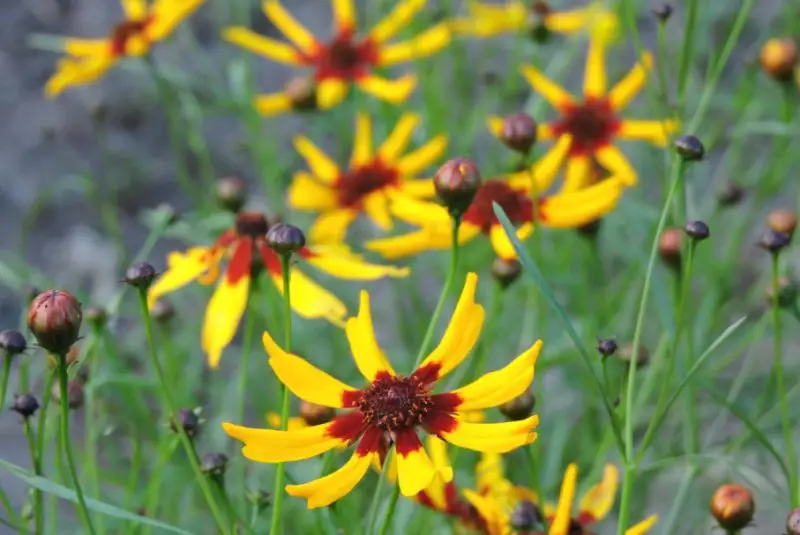
Mardi Gras is a festive and colorful coreopsis variety with bright yellow petals splashed with red markings near the center. The bicolor pattern gives it a unique and cheerful appearance, perfect for brightening mixed flower beds or cottage gardens. Its bold colors make it a focal point in any planting scheme.
This variety grows up to 15 to 18 inches tall, forming an upright clump with multiple branching stems. It flowers continuously from early summer to fall, especially if regularly deadheaded. Its lively color mix makes it an attractive choice for pollinator gardens.
Mardi Gras grows best in full sun and well-draining soil and thrives in USDA Hardiness Zones 5 to 9. It is drought-tolerant and attracts bees and butterflies, making it a pollinator-friendly addition to gardens. Its low-maintenance nature also makes it suitable for beginner gardeners.
Mercury Rising
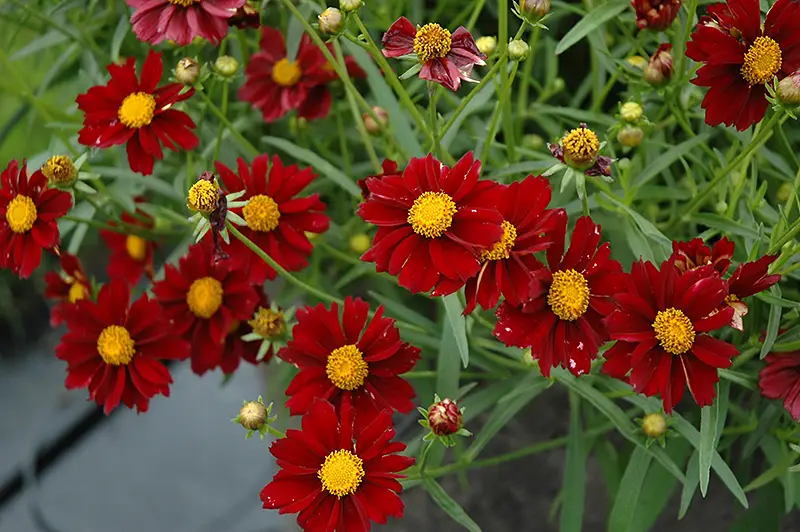
Mercury Rising is a stunning coreopsis variety known for its deep ruby-red petals with a velvety texture. Its bold, rich color contrasts beautifully with its green foliage, creating a dramatic effect in garden beds or borders. The large daisy-like flowers are long-lasting and perfect for cutting.
This variety reaches about 18 to 24 inches in height and has a bushy, clumping growth habit. Blooming from early summer to the first frost, it provides continuous color when deadheaded regularly. Its upright stems make it ideal for both garden display and fresh flower arrangements.
Mercury Rising thrives in full sun and well-drained soil, performing best in USDA Hardiness Zones 5 to 9. It is drought-tolerant once established and attracts bees and butterflies, making it an excellent choice for wildlife-friendly gardens.
Amulet
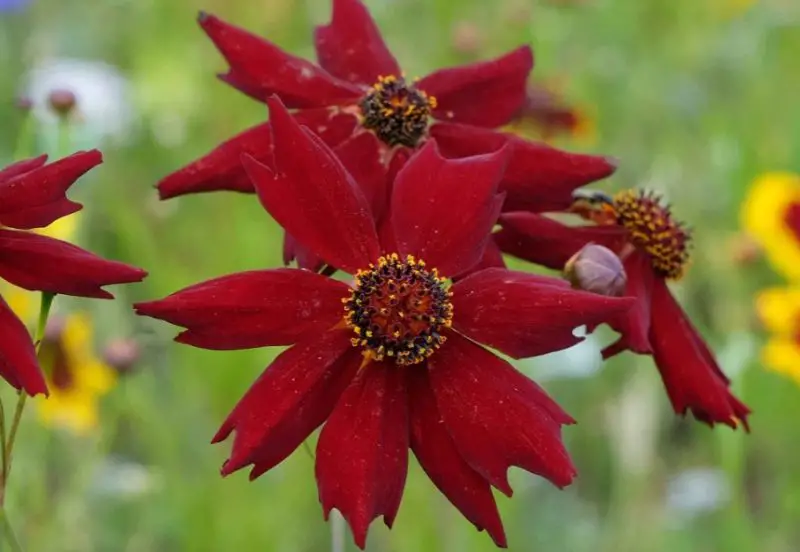
The Amulet coreopsis is a compact variety known for its bright golden-yellow, daisy-like flowers. Its blooms are dense and abundant, making it a great choice for garden borders or container planting. This variety is highly attractive to pollinators, including bees and butterflies, adding life and movement to any garden space.
It typically grows to a height of around 12 to 16 inches, making it a perfect low-growing option for edging pathways or flower beds. The flowers appear continuously from early summer through late fall if properly deadheaded. Its compact size and neat growth habit make it easy to maintain.
Amulet thrives in full sun and well-draining soil, performing best in USDA Hardiness Zones 4 to 9. Once established, it is drought-tolerant, requiring minimal watering. This variety is also resistant to most common pests and diseases, making it an excellent choice for beginner gardeners.
Crazy Cayenne
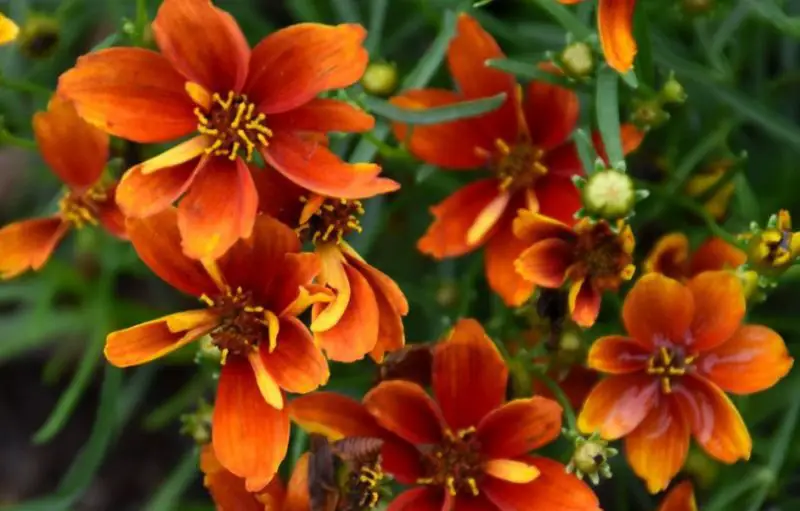
Crazy Cayenne is a vibrant and eye-catching coreopsis variety featuring bright orange-red petals with hints of golden undertones. Its bold, fiery colors make it stand out in any flower bed, especially when paired with contrasting perennials. The daisy-like flowers are slightly frilled at the edges, adding texture and visual appeal.
This variety reaches about 15 to 18 inches tall and has an upright, clumping growth habit. It blooms prolifically from early summer through the first frost, creating long-lasting seasonal color. Deadheading spent blooms will encourage continuous flowering.
Crazy Cayenne thrives in USDA Hardiness Zones 5 to 9 and prefers full sun with moderately fertile, well-drained soil. It is drought-resistant once established and attracts bees and butterflies, making it a great addition to pollinator-friendly gardens.
Double Sunburst
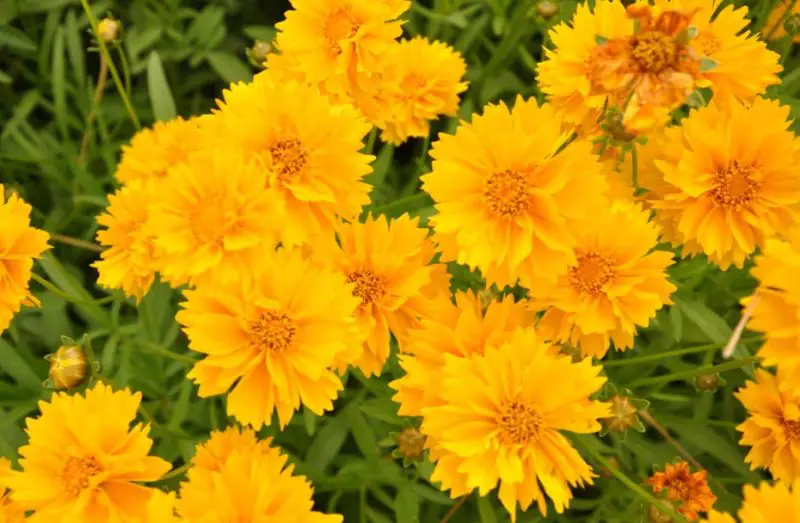
Double Sunburst is admired for its unique double-layered, golden-yellow blooms that resemble pom-poms. These flowers add a cheerful and textured look to garden beds and are excellent for cutting and arranging in vases. The dense, showy blossoms stand out beautifully against their bright green foliage.
This variety grows to about 18 to 24 inches in height, forming an upright clump. It has an extended blooming period, starting in early summer and lasting into fall, especially when regularly deadheaded. Its long stems make it suitable for fresh floral arrangements.
Double Sunburst performs best in full sun and well-draining soil and is hardy in USDA Zones 4 to 9. It is low-maintenance, heat-tolerant, and attracts pollinators such as bees and butterflies, making it a fantastic choice for wildlife gardens.
Moonbeam
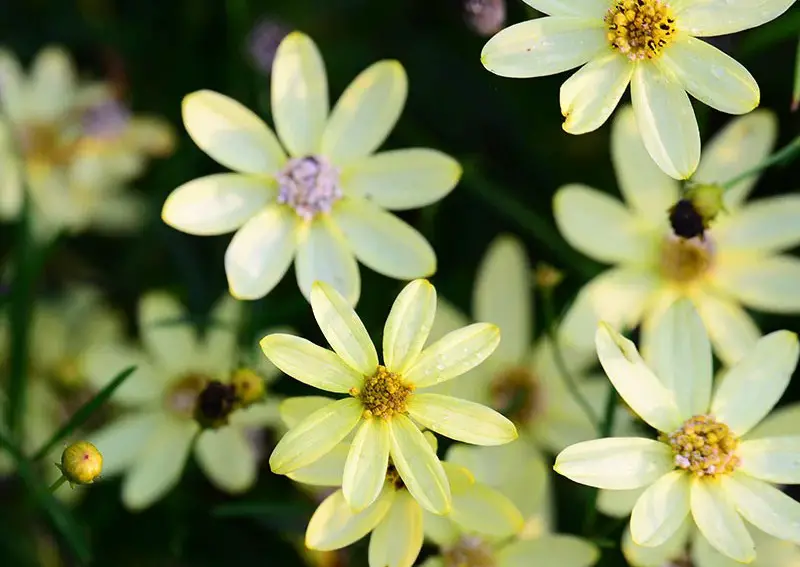
Moonbeam is a classic and widely loved coreopsis variety, featuring soft, pale yellow flowers that add a delicate and airy look to the garden. Its fine-textured, fern-like foliage enhances its graceful appearance, making it a great choice for cottage gardens or naturalized plantings.
This variety grows to about 12 to 18 inches tall and forms a spreading, mounded habit. It blooms profusely from early summer through fall, providing long-lasting seasonal color with minimal care. Its lacy foliage remains attractive even when not in bloom.
Moonbeam thrives in full sun and well-drained soil and is hardy in USDA Zones 3 to 9, making it one of the most cold-tolerant coreopsis varieties. It is drought-resistant and attracts pollinators such as bees and butterflies, making it ideal for pollinator gardens.
Pumpkin Pie
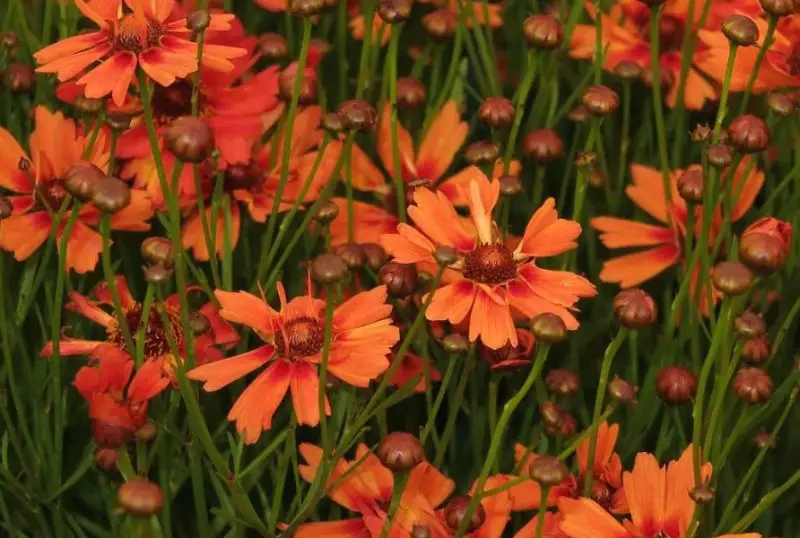
Pumpkin Pie is a warm-toned variety that produces soft pumpkin-orange flowers with a golden-yellow center. Its cheerful color adds a cozy autumnal feel to garden beds, containers, or borders. The daisy-like flowers are abundant, creating a carpet of vibrant color when in full bloom.
This variety typically grows 12 to 16 inches tall with a compact, clumping habit. It blooms continuously from summer to fall, especially when deadheaded regularly. Its neat growth pattern makes it suitable for edging pathways or planting in mixed borders.
Pumpkin Pie performs best in full sun and well-draining soil, thriving in USDA Hardiness Zones 5 to 9. It is drought-tolerant once established and attracts bees and butterflies, making it a great addition to pollinator-friendly gardens.
Radiant Tigrina
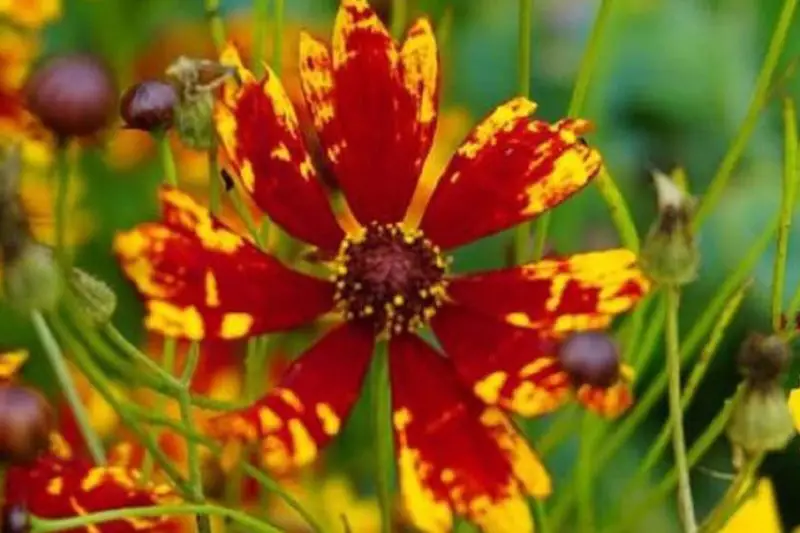
Radiant Tigrina is an eye-catching coreopsis variety distinguished by its unique bicolor petals—bright yellow tipped with deep red near the center. The striking color combination gives it a lively and exotic look, perfect for adding contrast to flower beds and cottage gardens.
This variety reaches 15 to 18 inches in height and has an upright, clumping growth habit. It blooms from early summer to fall, producing masses of cheerful flowers that brighten the garden for months. Regular deadheading enhances its blooming performance.
Radiant Tigrina grows best in full sun and well-drained soil and thrives in USDA Zones 5 to 9. It is drought-resistant, low-maintenance, and a magnet for bees and butterflies, making it an excellent pollinator-friendly choice.
Red Chiffon
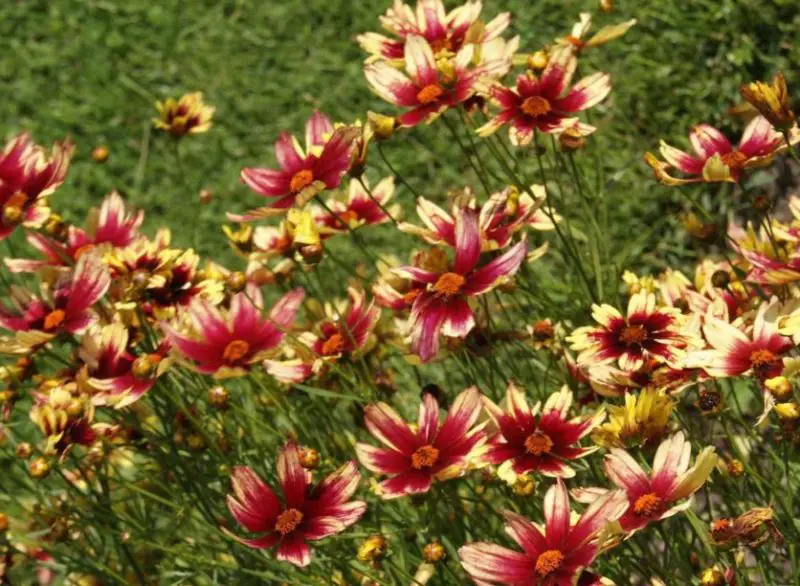
Red Chiffon is a charming coreopsis variety featuring soft, semi-double red blooms with a velvety texture. The flowers are slightly ruffled, giving them an elegant, airy appearance that pairs beautifully with other summer perennials. Its rich red color adds depth and warmth to any planting scheme.
This variety typically grows 18 to 24 inches tall and forms a loose, clumping habit. It blooms continuously from summer into fall, especially with regular deadheading. Its long stems make it suitable for cutting and floral arrangements.
Red Chiffon thrives in full sun and well-draining soil, performing well in USDA Zones 5 to 9. It is drought-tolerant once established and attracts pollinators, making it ideal for wildlife gardens and low-maintenance landscapes.
Red Elf
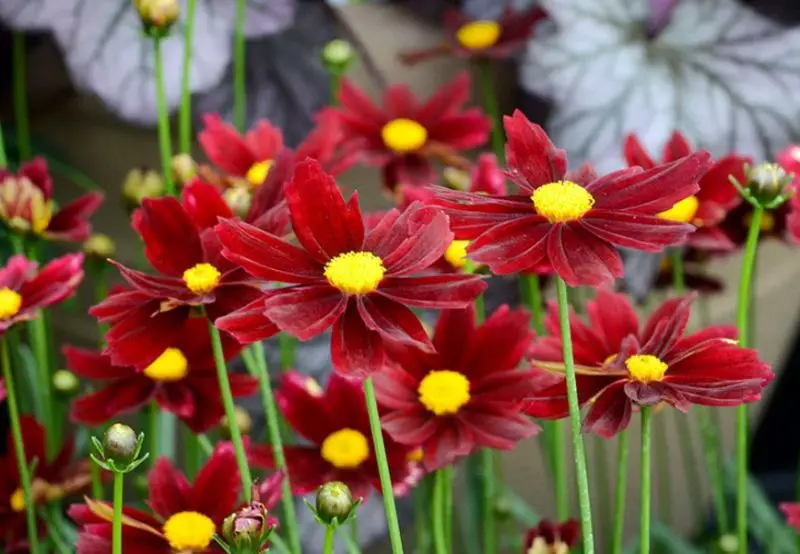
Red Elf is a compact and vivid coreopsis variety that produces bright cherry-red flowers with a golden-yellow center. Despite its small stature, the plant blooms abundantly, creating a bold splash of color in containers, borders, or rock gardens. Its flowers are daisy-like and slightly rounded at the tips.
This variety grows to a modest height of about 8 to 10 inches, making it ideal for low borders or as a colorful groundcover. It begins blooming in early summer and continues through the fall, especially when spent flowers are removed regularly.
Red Elf thrives in full sun and well-drained soil and is well-suited for USDA Hardiness Zones 5 to 9. It is drought-tolerant, low-maintenance, and highly attractive to butterflies and bees. This variety is also a great option for small gardens or container arrangements.
Red Satin
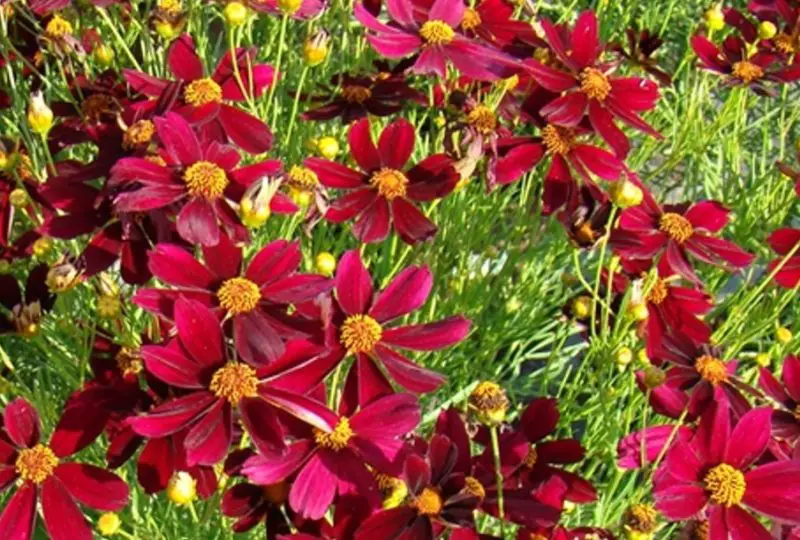
Red Satin is a standout variety known for its deep red, satiny blooms and lacy green foliage. The flowers are large for a coreopsis and have a velvety sheen that catches the light beautifully. This elegant plant adds richness and contrast to sunny beds and borders.
Reaching 18 to 24 inches in height, Red Satin has a tidy, mounded form and upright stems that hold the flowers above the foliage. It begins blooming in early summer and will continue well into fall with regular deadheading.
Hardy in USDA Zones 4 to 9, Red Satin performs best in full sun and well-drained soil. It is drought-resistant, deer-resistant, and a magnet for pollinators like bees and butterflies. It also makes an excellent cut flower for arrangements.
Sterntaler
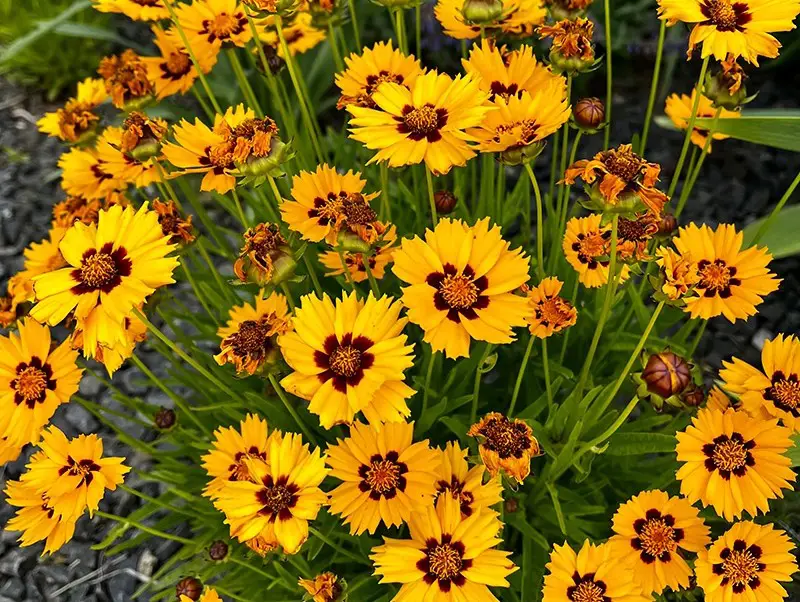
Sterntaler is a classic, cheerful coreopsis variety with golden-yellow petals and a bold maroon-red center. The contrast between the two colors gives the flower a sunburst effect, making it a vibrant addition to any sunny garden space.
This variety typically grows 12 to 18 inches tall and forms a bushy, rounded clump. It blooms from early to mid-summer, with the possibility of extended flowering into fall if regularly deadheaded. The sturdy stems hold up well against wind and rain.
Sterntaler thrives in full sun and well-drained soil and is suitable for USDA Zones 4 to 9. It is tolerant of heat and drought once established and is particularly attractive to pollinators, especially butterflies. Its bright, two-tone flowers are ideal for both borders and containers.
Sunburst
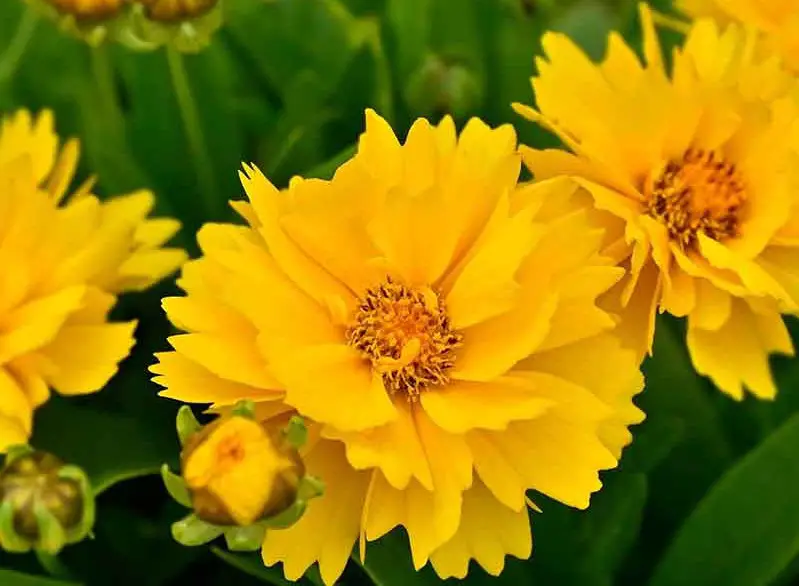
Sunburst is a striking variety that features large golden-yellow blooms with rich red markings at the base of each petal. These bicolor flowers resemble little sunbursts, making this plant a favorite for lively, energetic garden designs.
It grows to about 18 to 24 inches tall with an upright, branching habit. Blooming begins in early summer and lasts into early fall, especially with consistent deadheading. Its long stems and vivid flowers make it suitable for cutting.
Sunburst thrives in USDA Hardiness Zones 5 to 9 and prefers full sun and well-draining soil. Like most coreopsis, it is drought-tolerant once established and beloved by pollinators. Its bright flowers make it perfect for wildflower meadows or bold border plantings.
Sunfire
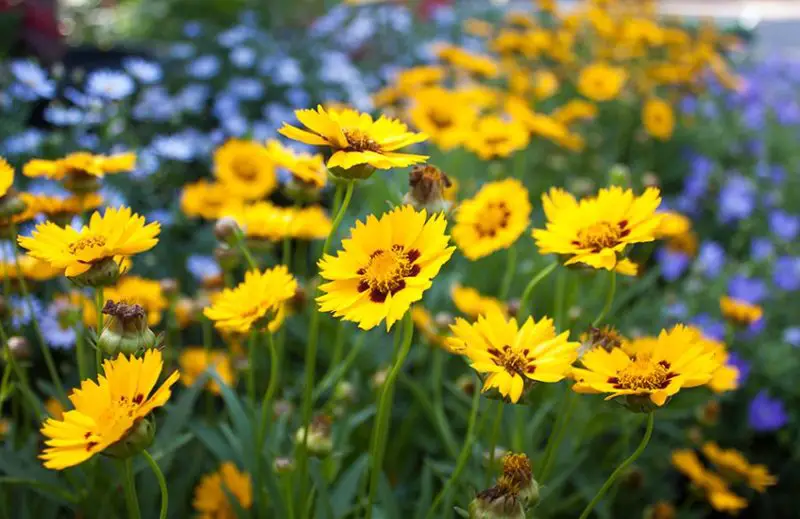
Sunfire is another radiant bicolor variety featuring golden-yellow petals with a deep red eye. The red coloration often bleeds into the petal bases, creating a dynamic, sun-washed effect. It brings a warm, glowing presence to garden beds and containers alike.
Growing to around 12 to 18 inches tall, Sunfire forms a compact, mounding shape that holds its blooms aloft. It starts flowering in late spring and continues through the summer months with regular deadheading. Its neat habit makes it a popular edging plant.
Sunfire grows best in full sun and well-drained soil and is hardy in USDA Zones 4 to 9. It tolerates dry conditions and poor soils and attracts butterflies, making it an excellent option for pollinator gardens and low-maintenance landscapes.
Tall Red
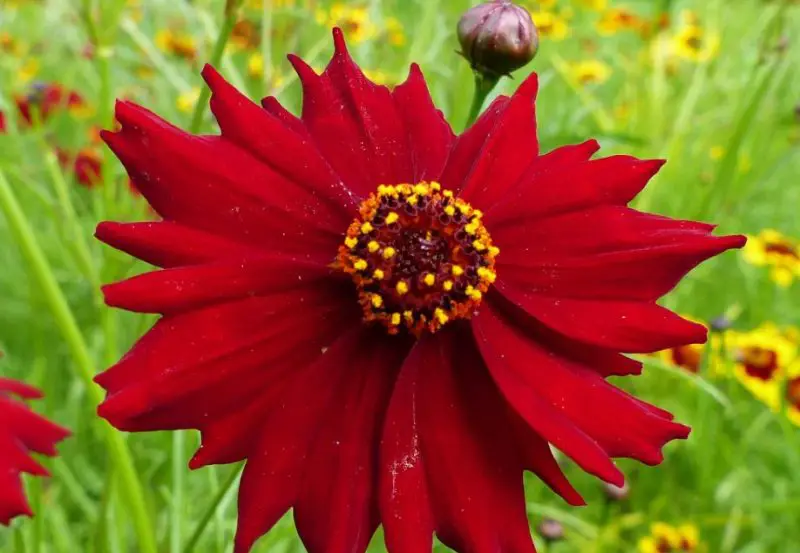
Tall Red is a bold and striking coreopsis variety, recognized for its rich crimson-red blooms that stand out dramatically against green foliage. Its tall stature makes it an excellent choice for the back of flower beds or as a focal point in mixed perennial borders. The daisy-like flowers have a velvety texture, giving them a luxurious appearance.
This variety can reach heights of 24 to 30 inches, making it one of the taller coreopsis cultivars. It has an upright, clumping growth habit and produces abundant flowers from early summer through fall, especially if spent blooms are removed regularly.
Tall Red thrives in full sun and well-drained soil and is hardy in USDA Hardiness Zones 5 to 9. It is heat- and drought-tolerant once established and is highly attractive to pollinators like bees and butterflies, making it a great addition to wildlife-friendly gardens.
Zagreb
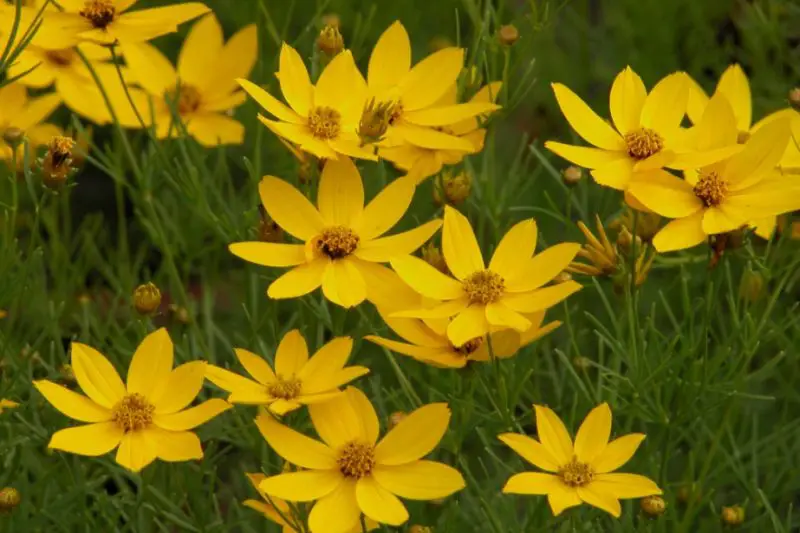
Zagreb is one of the most popular and reliable coreopsis varieties, known for its bright golden-yellow, thread-like flowers and fine, ferny foliage. The dense, airy blooms create a soft, textured look, making it ideal for naturalized plantings, cottage gardens, or mass plantings.
It typically grows to about 12 to 18 inches tall and forms a compact, mounded shape. Zagreb blooms continuously from early summer into early fall, requiring minimal maintenance to keep its neat appearance. Its feathery foliage remains attractive even when not in bloom.
This variety thrives in full sun and well-drained soil and is hardy in USDA Zones 3 to 9, making it suitable for colder climates. Drought-tolerant and deer-resistant, Zagreb also attracts bees and butterflies, making it a perfect choice for pollinator gardens.
FAQs About Coreopsis Varieties
What is the best Coreopsis variety for beginners?
Moonbeam and Zagreb are excellent choices for beginners. They are hardy, low-maintenance, and bloom profusely with minimal care. Both are drought-tolerant and thrive in a wide range of USDA zones.
Which Coreopsis varieties are best for cold climates?
Zagreb and Moonbeam are the most cold-hardy, thriving in USDA Zones as low as 3. These varieties handle frost well and return reliably each year in cooler regions.
What Coreopsis variety blooms the longest?
Mercury Rising, Moonbeam, and Red Satin are known for their long blooming periods, often flowering from early summer until the first frost when deadheaded regularly.
Are Coreopsis plants good for pollinator gardens?
Yes, all Coreopsis varieties attract bees, butterflies, and other pollinators. Brightly colored types like Crazy Cayenne, Sunfire, and Mardi Gras are especially appealing to butterflies.
Can Coreopsis grow well in containers?
Compact varieties such as Amulet, Red Elf, and Hot Paprika are perfect for containers. They have neat, clumping growth habits and bloom continuously through the summer.





